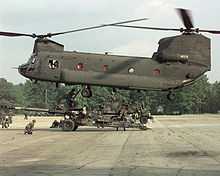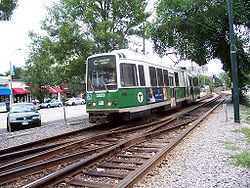Boeing Rotorcraft Systems

Boeing Rotorcraft Systems (formerly Boeing Helicopters and before that Boeing Vertol) is the former name of a US aircraft manufacturer, now known as the Mobility Division of Boeing Military Aircraft, a division of Boeing Defense, Space & Security. The headquarters and main rotorcraft factory is in Ridley Park, Pennsylvania, a suburb of Philadelphia. Production of Apache attack helicopters in Mesa, Arizona, formerly part of Rotorcraft Systems, is now under the Global Strike Division of Boeing Military Aircraft.
History
Background
Boeing Helicopters was created as Boeing Vertol when the Vertol Aircraft Corporation (formerly Piasecki Helicopter) company of Morton, Pennsylvania was acquired by Boeing in 1960; the Vertol name was an abbreviation for Vertical Take Off and Landing. Other names by which the division sometimes referred to itself in correspondence over the years were "Boeing Aircraft Company, Vertol Division" and "Boeing Philadelphia". The company was responsible for the design and production of the CH-46 Sea Knight and the CH-47 Chinook. The name became Boeing Helicopters in 1987, and the current name was adopted in 2002.[1]
When Boeing merged with McDonnell Douglas, the former Hughes Helicopters operations in Mesa, Arizona were placed under Boeing Helicopters. A year and a half later Boeing sold the civilian line of helicopters to MD Helicopter Holdings Inc., an indirect subsidiary of the Dutch company, RDM Holding Inc.
By December 2006 Columbia Helicopters of Aurora, Oregon has purchased the Type certificate of the Boeing Vertol 107-II and Boeing Model 234 Commercial Chinook from Boeing.[2][3] The Columbia Helicopters is seeking FAA issuance of a Production Certificate to produce parts with eventual issuance of a PC to produce aircraft.
Mass transit
For much of the 1970s, Boeing Vertol entered the railroad rolling stock market in an attempt to keep government-funded contracts in the wake of the Vietnam War. During this period, Boeing Vertol manufactured the Morgantown Personal Rapid Transit system for West Virginia University, the 2400 series Chicago 'L' cars for the Chicago Transit Authority, and the US Standard Light Rail Vehicle (marketed as the Boeing LRV). It was the last vehicle, an attempt at a standardized light rail vehicle promoted by the federal Urban Mass Transportation Administration, that led to the company's ending rail production due to myriad problems. This cost Boeing and the vehicle's two buyers, Massachusetts Bay Transportation Authority and San Francisco Municipal Railway millions and led to premature retirements of the vehicles.
While the company's subway cars performed relatively better, they did not continue in the railcar business, as competitors may have underbid on a key contract and the post-Vietnam War military build-up provided far more lucrative military contracts.
Boeing Vertol products

Rotorcraft
- AH-6 Little Bird (acquired when Boeing merged with McDonnell Douglas)
- AH-64 Apache (acquired when Boeing merged with McDonnell Douglas)
- Boeing Model 234 Commercial Chinook
- Boeing Model 360 (an all composite, private venture, technology demonstrator)
- Boeing Vertol 107-II
- Boeing Vertol XCH-62 (Model 301)
- Boeing Vertol YUH-61
- CH-46 Sea Knight
- CH-47 Chinook
- CH-113 Labrador
- V-22 Osprey (built as a teaming arrangement with Bell Helicopter Textron)
Rail


- US Standard Light Rail Vehicle (aka the Boeing LRV)
- Morgantown Personal Rapid Transit
- Boeing Vertol 2400-series rapid transit cars - Chicago 'L' cars
See also
References
- ↑ Holmes, Doug (07 2005). "'Rocky Road', Philadelphia site is no one-hit wonder". Boeing Frontiers. Boeing. Retrieved 16 March 2013.
- ↑ "Type Certificate Data Sheet No. 1H16" (PDF). Federal Aviation Administration. 2007-01-17. Retrieved 2007-02-08.
- ↑ "Type Certificate Data Sheet No. H9EA" (PDF). Federal Aviation Administration. 2007-01-17. Retrieved 2007-02-08.
Further reading
- Jonathan M. Feldman (author), Gerald I. Susman and Sean O'Keefe, eds. "Chapter 18, The Defense Industry in the Post-Cold War Era: Corporate Strategy and Public Policy Perspectives", The Conversion of Defense Engineers' Skills: Explaining Success and Failure Through Customer-Based Learning, Teaming and Managerial Integration, pp. 281–318. Oxford: Elsevier Science, 1998: .
External links
| ||||||||
| ||||||||||||||